
views
- Apply a warm compress over your ear for 10-15 minutes to loosen fluid and soothe ear pain.
- Run a humidifier to add moisture to the air and encourage natural ear fluid drainage.
- Try OTC medications like guaifenesin, steroidal nasal sprays, or an oral antihistamine.
- See your doctor if symptoms persist for more than 2 days. Your doctor will likely give you antibiotics and prescription ear drops.
Home Remedies

Yawn, chew, or swallow repeatedly to pop your ears. Simple mouth movements like these can help pop your ears, which allows the blocked fluid to drain freely and normally. Give these movements a try to see if you get any relief. Drinking water can help with the swallowing movements. Pinching your nose as you swallow may also help things along.
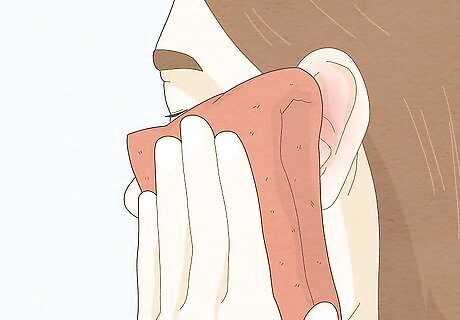
Apply a warm compress to loosen fluid and soothe pain. Place a warm, moist washcloth over the affected ear to lessen the pain and throbbing ache. You can use any warm compress, such as a hot towel wrung out in warm-to-hot water, against the ear for immediate relief. Make sure that the water isn't too hot, especially when using this method on children. Even placing a hot water bottle near the ear may help to draw out ear fluid.
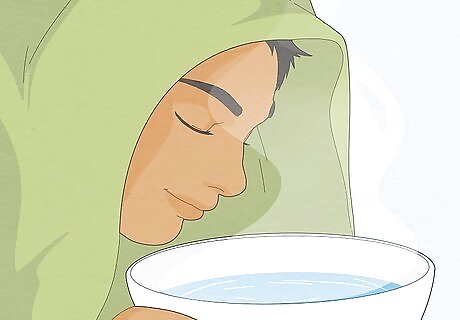
Inhale steam to open blocked Eustachian tubes. Fill a large bowl with boiling water. Cover your head with a towel and hold your ear over the steam bath. Try not to crane your neck, and only stay under the towel for 10-15 minutes. You can also try taking a hot shower to see if the steam helps loosen and drain the ear fluid.

Run a humidifier to add moisture to the air. When you're ready to sleep, place a humidifier in your bedroom on a side table so it’s close to your affected ear. This moist air can help ease and alleviate the buildup of fluid in your ear. Humidifiers are good during the wintertime because the air in most homes is dry due to central heating. For children, a cool mist humidifier is recommended — it decreases the risk of getting burned or injured.Tip: In most cases the fluid that collects in the inner ear fixes itself, unless it is the result of a chronic condition or persistent ear infections. See a doctor for further evaluation if these strategies don’t help.
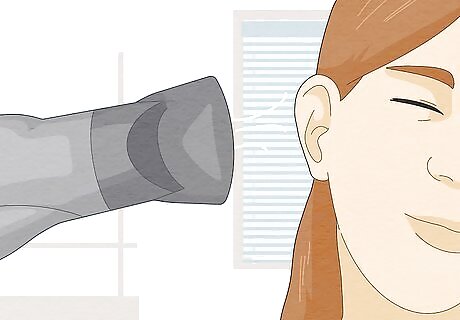
Use a blow dryer on a low setting to dry out ear fluid. Though this technique is highly debated, some people have had anecdotal success with it. To try it, just set a hair dryer on the lowest heat and hold the mouth of the dryer about 1 ft (0.30 m) from your ear. The idea is that the warm and dry air will turn the fluid in your ear to steam and help draw it out. Take caution not to burn your ear or the side of your face. If you feel any pain or overly hot, stop using the dryer.
OTC Medications
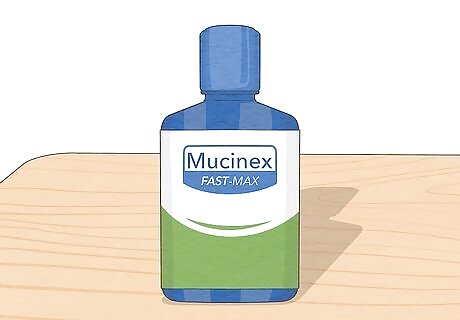
Take a mucus-thinning medication such as guaifenesin. This medication can help the fluid in your ears to drain by thinning out the mucus in your body. Look for a product that contains guaifenesin only and take the medication according to the manufacturer’s directions. This medication comes in different versions including tablets that you take every 4 hours and extended-release tablets that you take every 12 hours. Guaifenesin is often combined with other medications, such as cough suppressants, antihistamines, and decongestants, so check the ingredients carefully before buying.
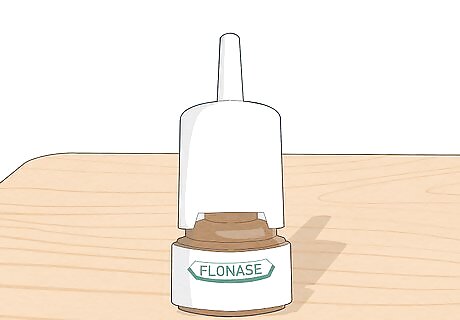
Use a nasal steroid spray to promote fluid drainage. It’s important to manage any underlying allergies to keep fluid out of your ears. OTC nasal steroid sprays may help to open up the Eustachian tubes and promote ear fluid drainage. These sprays work by reducing inflammation in the nose, which in turn helps to clear out the Eustachian tube. Note that it takes a few days for the steroid to build up to its full effect; this means that you will not experience immediate relief.
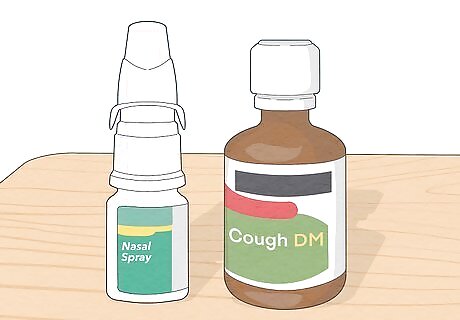
Try a decongestant medication. You can get OTC decongestant medications in the form of nasal sprays or as oral medication and they can be purchased at most pharmacies. Be sure to follow any instructions on the label. Avoid using nasal decongestant sprays for more than 3 days. Long-term use has been linked to "rebound" swelling of the nasal passages. Children may experience other side effects, such as hyperactivity, restlessness, and insomnia. Consult your doctor before using any nasal decongestant spray or oral decongestants.

Try an oral antihistamine. Some people find oral antihistamines useful for clearing a sinus infection because they can ease nasal congestion. However, antihistamines can have serious side effects for the sinuses, including the drying up of the mucous membranes of the nasal tissue and thickening the secretions. Consult your doctor to see if antihistamines may be helpful in your situation. Antihistamines are not recommended for the treatment of uncomplicated sinusitis or ear infections. Other side effects include drowsiness, confusion, blurred vision or, in some children, moodiness and overstimulation.
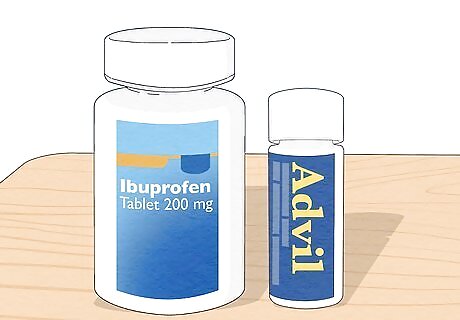
Take an over-the-counter pain medication. Your doctor may recommend the use of over-the-counter acetaminophen (Tylenol) or ibuprofen (Motrin IB, Advil) to relieve pain and ease any discomfort. Be sure to follow the dosage specified on the label.Warning: Use caution when giving aspirin to children or teens. Aspirin is technically considered appropriate for ingestion by children over two years old. However, because aspirin has recently been linked with Reye's syndrome, a rare condition that can cause severe liver and brain damage in teenagers recovering from chickenpox or the flu, use caution when giving aspirin to adolescents.
Medical Treatment

See a doctor if symptoms last longer than 2-3 days. Since most ear infections clear up on their own, many physician associations support the "wait-and-see" approach, which essentially means administering at-home treatment and pain relief but not treating the infection with antibiotics.Warning: If you notice any discharge of fluid, pus or bloody discharge, see a doctor immediately. Many doctors support this approach because of the limitations and overuse of antibiotics. In addition, antibiotics can't treat an infection caused by a virus. The American Academy of Pediatrics and the American Academy of Family Physicians recommend the "wait-and-see" approach for children from 6 months old to 2 years old who experience ear pain in one ear and for children over two years who have pain in one or both ears for less than two days and have a temperature of less than 102.2°F (39°C).
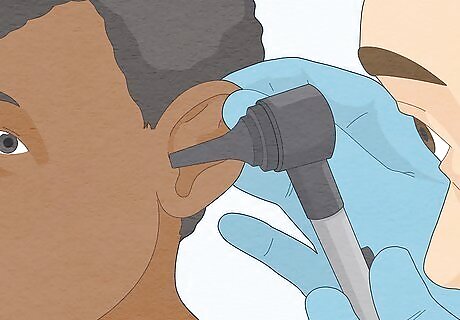
Describe your symptoms to your doctor. Be prepared to answer questions about the onset and nature of your (or your child's) symptoms. The physician will then examine the ear using an otoscope, a small instrument that looks like a flashlight that allows them to see into the eardrum. Common symptoms of an ear infection include ear pain, decreased hearing, ear tugging (if the child can't yet verbalize pain), and fever. Some people may experience a feeling of fullness in their ear or a "popping" sensation. You may be referred to a specialist in ear, nose and throat (ENT) disorders (otolaryngologist) if the problem is persistent, frequent, or unresponsive to treatment.

Take a full course of antibiotics if your doctor prescribes them. If you have a persistent infection, your doctor will likely prescribe a 10-day course of antibiotics, which can treat the infection and potentially shorten symptoms. Antibiotics are often prescribed for individuals who suffer from frequent infections or for those with severe and extremely painful infections. Commonly prescribed antibiotics include Amoxicillin and Zithromax (the latter if you're allergic to penicillin). A shorter course of antibiotic treatment (5-7 days instead of 10) may be prescribed for children ages 6 and up who have a mild to moderate infection. Even when symptoms improve, make sure to finish the full prescription. A persistent high fever (of over 100°F or 37.8°C) suggests resistance to that particular antibiotic and you may need to ask for a different prescription.Tip: Note that even after antibiotic treatment, fluid may remain in the ear for several months. Consult your doctor after the course of antibiotic treatment has ended to check on the infection and determine whether fluid is still present. Your doctor will usually want to see you about a week after the end of the antibiotic treatment.
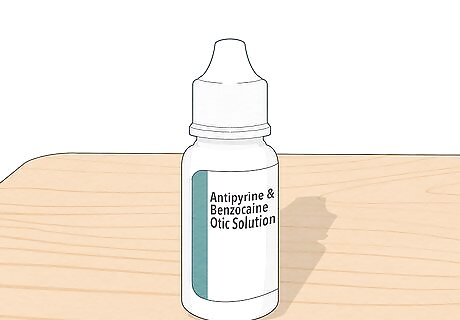
Administer prescription ear drops to relieve ear pain. Your doctor may prescribe ear drops, such as antipyrine-benzocaine-glycerin (Aurodex) to relieve pain as long as the eardrum remains intact and not torn or ruptured. Administer the drops as directed on the label and follow the recommended dosage. To administer drops to a child, warm the bottle by placing it in warm water. This will make the drops less of a shock to the ear. Then, have your child lie down on a flat surface with the infected ear facing you.

Undergo a myringotomy for severe cases if your doctor recommends it. Ear surgery may be an option in cases of prolonged ear fluid or frequent ear infections that don't clear up through antibiotics. The surgery involves draining the fluid from the middle ear and inserting a ventilation tube. Usually, you will need to be referred to an ENT to determine whether this surgery is appropriate. In this outpatient surgery, an ENT specialist will surgically place the tympanostomy tube into the eardrum through a small incision. The process helps ventilate the ear, prevents the buildup of more fluid, and allows existing fluid to drain. Some tubes are intended to stay in place for 6 months to 2 years and then fall out on their own. Other tubes are designed to stay in longer and may need to be surgically removed. The eardrum usually closes up again after the tube falls out or is removed.
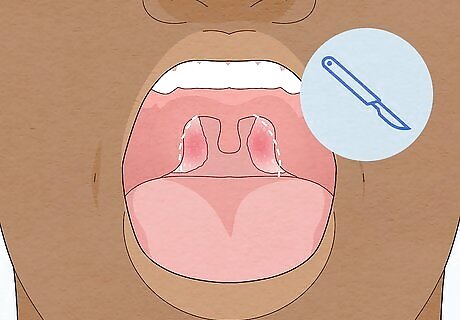
Discuss having an adenoidectomy with your doctor. This surgery is sometimes an option in cases of recurrent or persistent problems with the ears. The Eustachian tube runs from the ear to the back of the throat and is met by the adenoids. When inflamed or swollen (due to a cold or sore throat) the adenoids can press on the entrance of the Eustachian tubes. Moreover, bacteria on the adenoids can sometimes spread up into the tubes, causing infection and blockages. In this surgery, more common in children whose adenoids are larger and thus more likely to cause problems, an ENT specialist removes the adenoids through the mouth while the patient is under anesthetic. In some hospitals, the adenoidectomy is done as a day surgery, meaning that you can go home the same day. In other cases, surgeons like to keep the patient in hospital overnight for supervision.




















Comments
0 comment